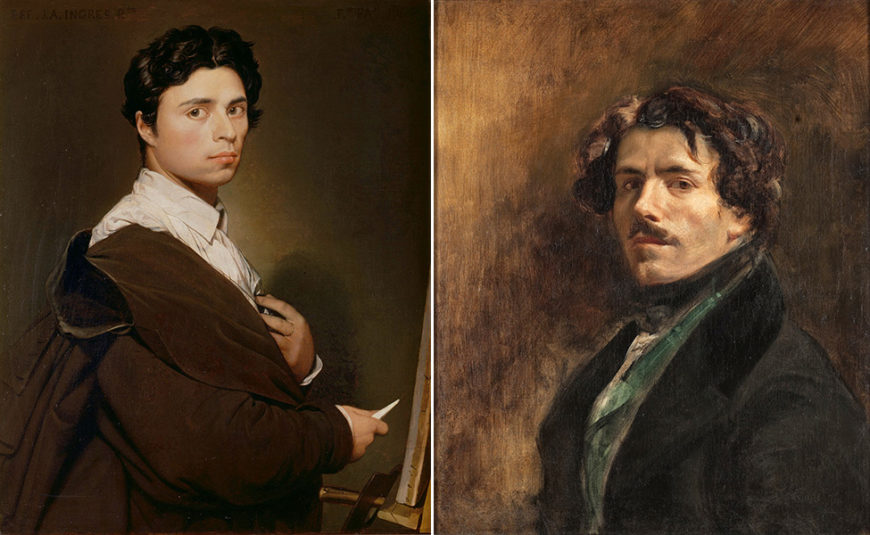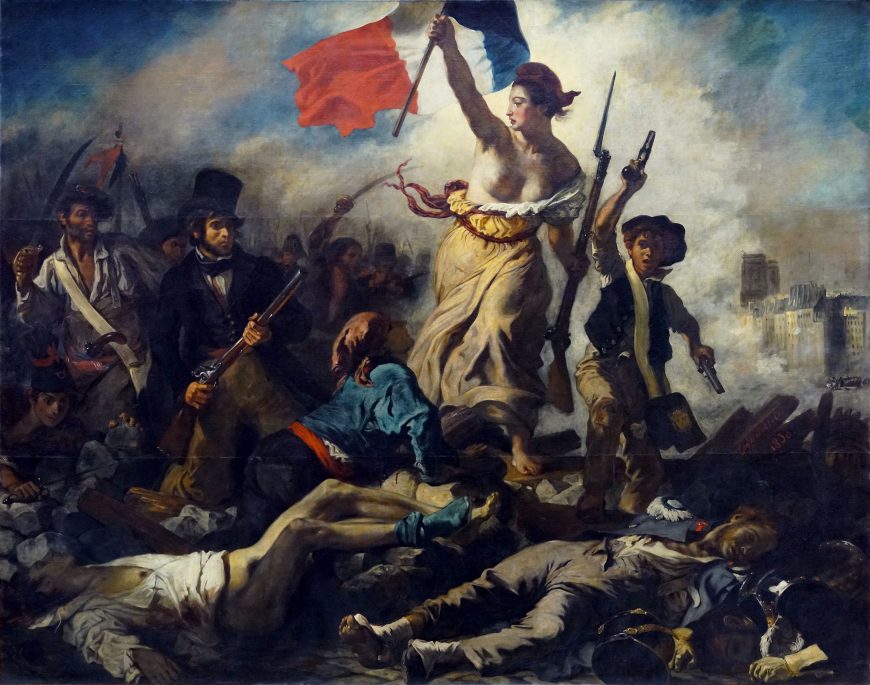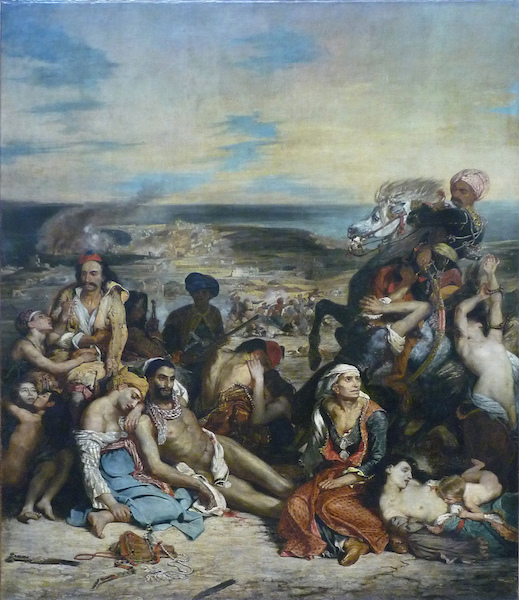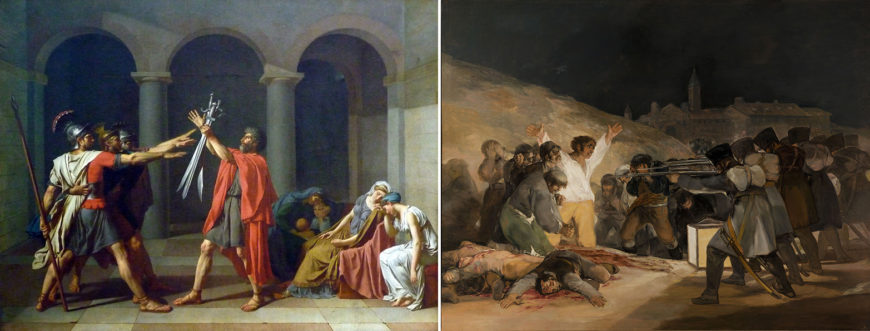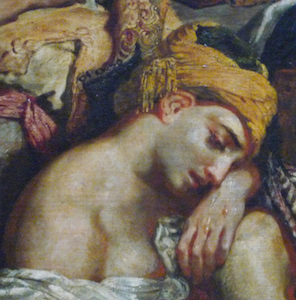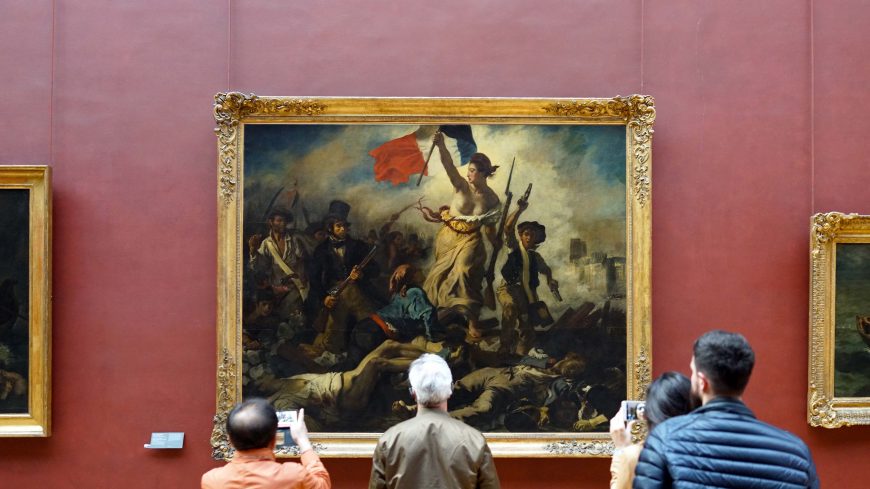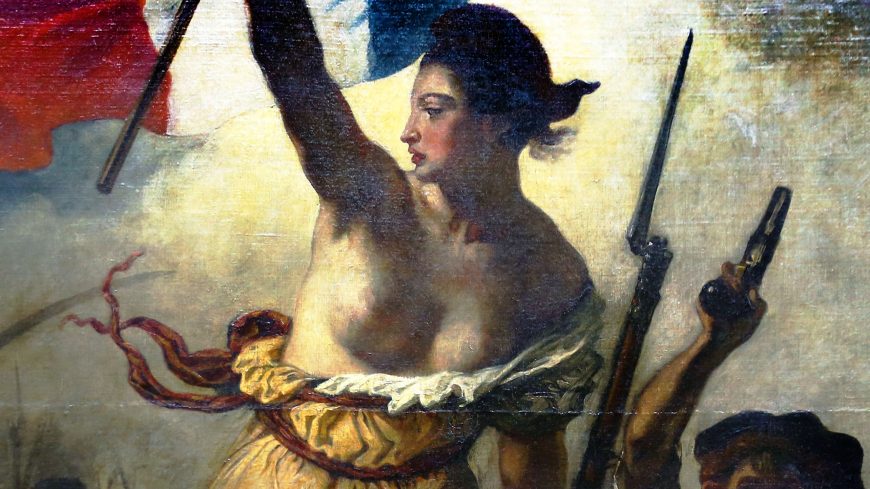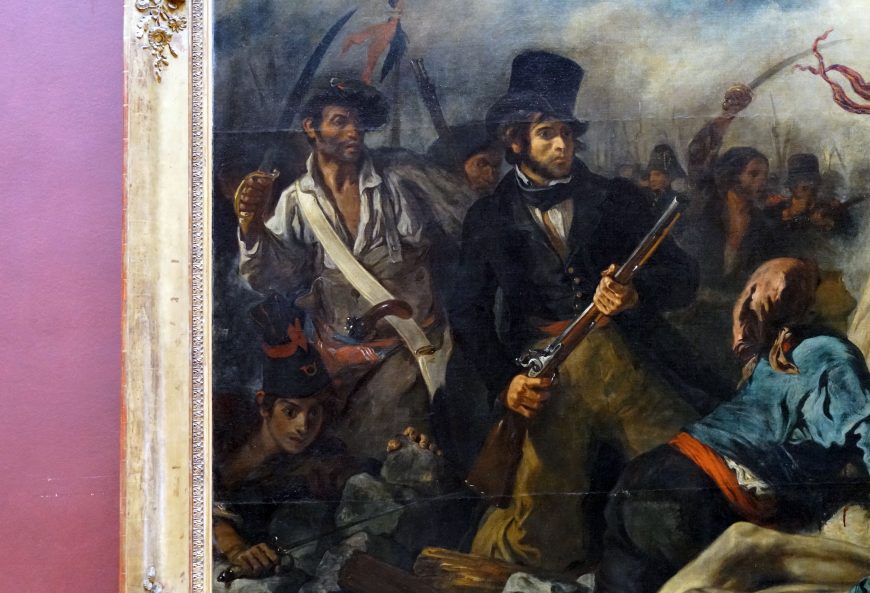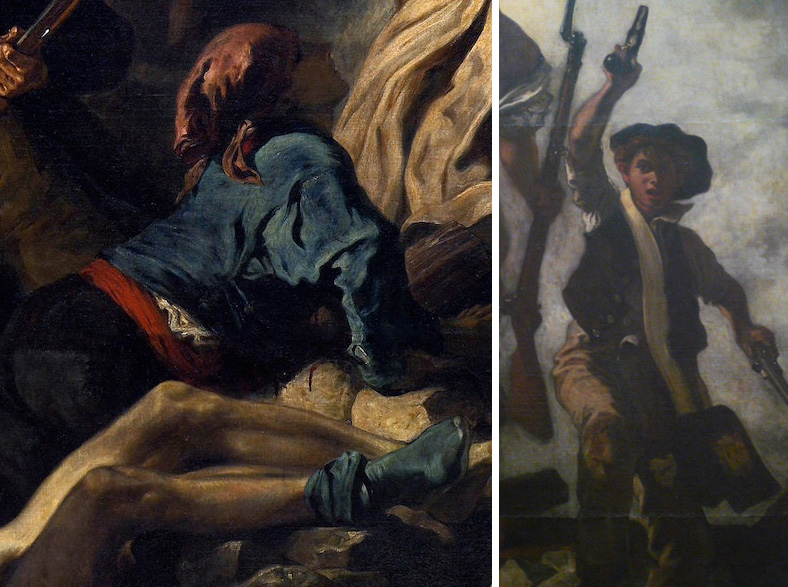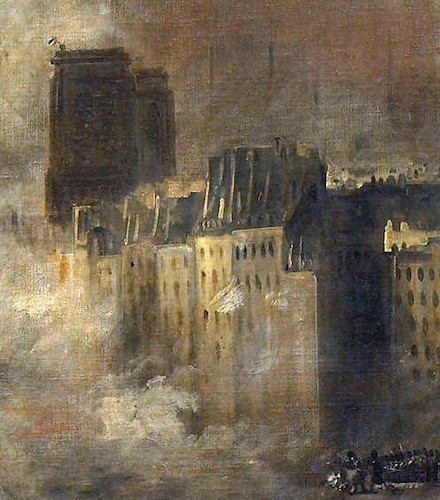Eugène Delacroix, Liberty Leading the People (July 28, 1830), September–December 1830, oil on canvas, 260 x 325 cm (Musée du Louvre, Paris)
Liberty Leading the People
Do you hear the people sing? Singing a song of angry men? It is the music of a people. Who will not be slaves again.
Clearly, this figure is not meant to be a portrait of a specific individual, and Delacroix did not mean to suggest that there was a half-naked woman running around carrying a loaded firearm and a flag during the Trois Glorieuses—the Three Glorious Days as it came to be known—of the July Revolution. Instead, she serves as an allegory—in this instance, a pictorial device intended to reveal a moral or political idea—of Liberty. In this, she is similar to an example familiar to those in the United States, Frédéric Auguste Bartholdi’s Statue of Liberty (1886). Clearly, this monumental statue is not a portrait of a woman named Liberty who wears a Roman toga, carries a torch, and an inscribed tablet. Instead, she represents an idea. The same is true of Delacroix’s painted Liberty.
This factory worker provides a counterpoint to the younger man beside him who is clearly of a different economic status. He wears a black top hat, an open-collared white shirt and cravat, and an elegantly tailored black coat. Rather than hold a military weapon like his older brother-in-arms, he instead grasps a hunting shotgun. These two figures make clear that this revolution is not just for the economically downtrodden, but for those of affluence, too.
A modern subject
Smarthistory images for teaching and learning:
[0:00] [music]
Dr. Steven Zucker: [0:05] We’re in the Louvre in Paris, looking at a large canvas by Delacroix, “Liberty Leading the People.” This painting dates to 1830. This is Romanticism.
Dr. Beth Harris: [0:15] It depicts an event of 1830. This is a contemporary subject. It’s important to remember that large paintings like this were generally reserved for history paintings — at least, according to the rules of the Academy — but here, like Géricault before him, Delacroix is taking on a contemporary subject. This is something that people in Paris experienced in July of 1830.
Dr. Zucker: [0:37] This was the revolution that ousted the reactionary king Charles X and installed on the throne the more moderate king Louis-Philippe.
Dr. Harris: [0:45] But we’re seeing a moment where the outcome of the revolution is not sure. We’re seeing fighting on the streets of Paris. We see the very recognizable cathedral of Notre-Dame in the background.
Dr. Zucker: [0:56] Notre-Dame was a symbol of the monarchy. It was a symbol of conservatism, and yet Delacroix represents at the top of one of its towers the tricolor, the flag of the revolutionaries.
Dr. Harris: [1:07] Liberty is an allegorical figure. She is a symbol of an idea that led the revolutionaries, many of them, to give up their lives to oust a conservative and reactionary monarch.
Dr. Zucker: [1:20] One might just think of the Statue of Liberty. That’s not an actual person. It’s a personification of an idea. Here, too, this woman is a personification of the idea of liberty, the idea of freedom.
[1:31] The fact that her breasts are visible is a reference to antiquity, to the birth of democracy, to ancient Greece and the Roman Republican tradition.
Dr. Harris: [1:39] Liberty strides across the barricade, this barrier that has been set up in the streets of Paris.
Dr. Zucker: [1:45] Paris was still a medieval city with narrow, winding streets. The grand boulevards of the later 19th century had not yet been built, and so what the revolutionaries did is they dug up the cobblestones that paved the streets and they piled them up and erected these barricades that were both defensive positions but also impeded the movements of the Royalist troops.
Dr. Harris: [2:03] What’s fascinating to me is this call by Liberty to climb over the barricade, to trespass that barrier and to move forward, to continue to fight even more aggressively for these ideals.
Dr. Zucker: [2:16] Liberty’s face is shown in a perfect classical profile, recalling ancient Greek and Roman images. In doing so, she’s also turning around to call the rebels forward. We can see this throng of people moving into the distance.
[2:30] In the foreground, we see two very particular figures. We see a man with a pistol in his waist. He wears a shirt with no jacket. He’s a member of the lower class, but the pin in his hat expresses that he’s got revolutionary sympathies.
Dr. Harris: [2:42] Delacroix’s clearly giving us this idea of people of all classes coming together, because the figure right next to the worker is more nicely dressed. He’s got a top hat on, a jacket, a vest. He holds a hunting rifle instead of a pistol.
Dr. Zucker: [2:56] And so this revolution is not only for the poor. It’s also for the middle classes.
Dr. Harris: [3:00] Which is what makes it so profoundly dangerous. This is not one class against another. These are the people coming together.
Dr. Zucker: [3:08] On the right side of the canvas is a boy who holds not one but two pistols and seems rather wild. He’s a schoolboy, and you know that from the velvet cap he wears and from the satchel at his side.
Dr. Harris: [3:18] Below him, we see two soldiers who have fallen, and so it’s not just that Delacroix’s giving us this sense of victory, of liberty, striding forward, but also the terrible costs of revolution.
Dr. Zucker: [3:31] Best summed up for me by the man in the lower left who’s wearing a nightshirt as if he’s been dragged from his bed and murdered by Royalist soldiers. He’s only wearing one sock. His shirt has drawn up, and so he’s nude from the waist down.
Dr. Harris: [3:43] His shirt is bloodied, and he’s incredibly close to us. In fact, his right arm is foreshortened and moves into our space, but the figures in the foreground of the dead and the dying and the wounded are all in our space.
[3:57] This is a painting much like Géricault’s “Raft of the Medusa” or Gros’ “Pest House at Jaffa,” that puts forward the violence in an unidealized way.
Dr. Zucker: [4:07] The entire scene is one of chaos, one of energy. It is filled with diagonals, with smoke, with movement, and yet Delacroix has also contrived a classicizing pyramid to organize all of these figures, creating a sense of order within the chaos.
[4:23] One of the reasons the painting feels so energetic is because of the loose brushwork and because of the brilliant colors that Delacroix uses. The tricolor, the blues in the sky, the red sash of the figure that looks up to Liberty, all stand out and are in stark contrast to the more muted colors that were traditional at this moment.
Dr. Harris: [4:41] Delacroix is violating so many of the rules of the Academy. This is not a painting with perfect finish. In other words, we easily see the hand of the artist, the brushwork. This is not a painting where we see a careful attention to line and contour. Rather, we have a sense of the openness of contours, of the looseness of the handling of the paint.
Dr. Zucker: [5:04] And the contingency of each of these figures, that if we waited just a moment, they would all have shifted position.
Dr. Harris: [5:09] This painting was purchased by King Louis-Philippe to show that he was a champion of republican values, and by republican, we mean the ideals of democracy, but before the decade was over in 1839, the painting was returned to Delacroix because it was perceived as dangerous. This was an image that showed people coming together to overthrow a king, after all.
[5:33] In 1848, at the time of the next revolution, when Louis-Philippe is ousted, this painting is returned to the museum once again. This is a good reminder of just how politicized art could be in the 19th century in France.
[5:46] [music]

